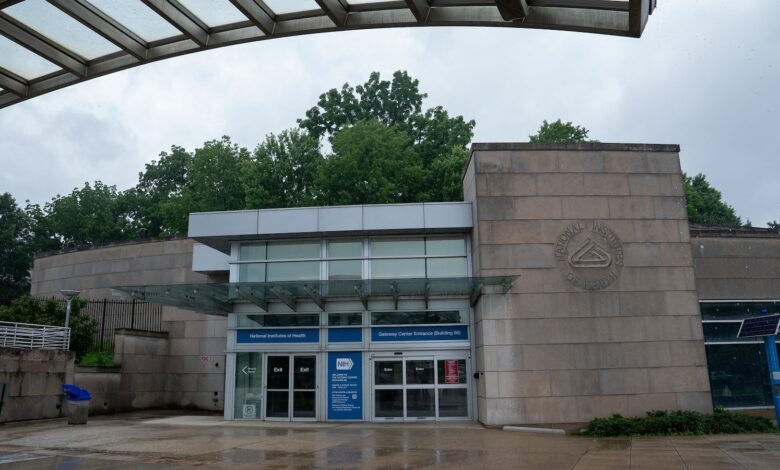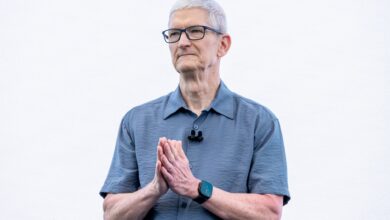NIH scientists sign open letter criticizing Trump administration’s grant cancellations, firings

The National Institutes of Health (NIH) is facing backlash from more than 300 scientists who have signed an open letter criticizing the Trump administration’s recent actions. The letter, addressed to NIH director Dr. Jay Bhattacharya, expresses concerns about the politicization of research, disruptions to global collaboration, and budget and staff cuts that are hindering the agency’s ability to conduct vital research.
The letter, signed by 92 scientists and endorsed by 250 anonymous but verified signatories, highlights the scientists’ dissent to administration policies that they believe are undermining the NIH’s mission and compromising public health. The signatories are speaking out against what they perceive as a prioritization of political considerations over human safety and the responsible use of public resources.
According to some of the NIH scientists who signed the letter, they have attempted to raise concerns internally without success. With Dr. Bhattacharya set to testify before the Senate Appropriations Committee on the proposed NIH budget, there is a sense of urgency among the signatories to make their voices heard.
Jenna Norton, a program officer at the NIH’s National Institute of Diabetes and Digestive and Kidney Diseases and one of the lead organizers of the letter, emphasized the importance of speaking up despite the risks involved. She urged her colleagues to consider not only the risks of speaking out but also the risks of remaining silent in the face of perceived injustices.
The letter, known as the Bethesda Declaration, takes its name from the location of the NIH headquarters in Bethesda, Maryland. It is modeled after the Great Barrington Declaration, a controversial document co-authored by Dr. Bhattacharya in October 2020. The Great Barrington Declaration proposed an alternative approach to handling the COVID-19 pandemic by avoiding lockdowns and focusing on protecting vulnerable individuals while allowing others to resume normal activities to achieve natural herd immunity.
The Bethesda Declaration calls on Dr. Bhattacharya to reverse grants that have been delayed or terminated for political reasons, to reinstate essential staff who were fired at the NIH, and to allow work with foreign collaborators. In response, Dr. Bhattacharya stated that while there may be misconceptions about the NIH’s recent policy directions, respectful dissent in science is important for progress.
A spokesperson for the Department of Health and Human Services clarified that the agency has not halted legitimate collaborations with international partners. The ongoing dialogue between the NIH scientists and agency leadership reflects the importance of transparency, accountability, and collaboration in advancing scientific research for the benefit of public health. In a recent statement, a spokesperson for the National Institutes of Health (NIH) revealed that other funders, such as the Gates Foundation, limit indirect costs to 15% and that each termination case is currently under review.
Ian Morgan, a postdoctoral researcher at the NIH’s National Institute of General Medical Sciences specializing in antimicrobial resistance, shared his distress over the changes within the agency. He described how the arrival of the Trump administration hindered his research efforts by preventing him from acquiring essential supplies for his lab and restricting his participation in a crucial conference in February. Witnessing the inadvertent termination and subsequent reinstatement of many of his colleagues was a jarring experience for Morgan.
Morgan emphasized that researchers at the NIH are driven by a desire to serve the public and conduct life-saving research, rather than monetary gain. The disruptive nature of the recent changes has had a profound impact on the scientific community at the NIH.
Sarah Kobrin, a branch chief at the NIH’s National Cancer Institute (NCI), also expressed concern over the termination of over 2,100 research grants totaling approximately $9.5 billion at the NIH. She noted a shift in her daily responsibilities as she now spends time on the phone addressing concerns from researchers whose projects have been abruptly discontinued, citing questionable justifications for their work’s lack of public health significance.
Both Morgan and Kobrin, who signed a public letter addressing these issues, urge individuals to show their support by signing the letter or contacting congressional representatives to voice their concerns. Morgan highlighted the importance of maintaining hope and unity within the scientific community to navigate through these challenging times.
The Trump administration has yet to respond to requests for comment on these developments.
The National Institutes of Health (NIH) continues to be a vital hub for groundbreaking research and innovative discoveries. Researchers like Ian Morgan and Sarah Kobrin are dedicated to advancing scientific knowledge and improving public health outcomes through their work at the NIH. As they navigate through turbulent times, their resilience and commitment to their mission remain unwavering.
By leveraging support from the scientific community and engaging with policymakers, researchers at the NIH strive to uphold the integrity of their work and promote the greater good for society. The challenges they face serve as a reminder of the importance of collaboration, advocacy, and perseverance in the pursuit of scientific excellence. The world of technology is constantly evolving, with new innovations and advancements being made every day. From the latest smartphones to cutting-edge artificial intelligence, there is no shortage of exciting developments to keep up with.
One area that has seen significant growth in recent years is the field of virtual reality (VR) technology. VR allows users to immerse themselves in a computer-generated environment, using special headsets and controllers to interact with the digital world around them. This technology has been used in a variety of industries, from gaming and entertainment to healthcare and education.
One of the most exciting applications of VR technology is in the field of healthcare. Doctors and researchers have been exploring how VR can be used to treat a variety of medical conditions, from chronic pain to post-traumatic stress disorder. By creating virtual environments that simulate real-life situations, patients can be exposed to their fears or triggers in a controlled setting, helping them to overcome their anxieties and phobias.
In addition to mental health, VR technology is also being used to improve physical health. Physical therapists are using VR simulations to help patients recover from injuries and surgeries, allowing them to practice movements and exercises in a safe and controlled environment. This can speed up the recovery process and improve outcomes for patients.
Another area where VR technology is making a big impact is in education. Teachers are using VR simulations to create immersive learning experiences for students, allowing them to explore historical events, travel to far-off places, and conduct virtual experiments. This hands-on approach to learning can help students retain information better and engage more fully with the material.
In the world of entertainment, VR technology is revolutionizing the way we experience media. Virtual reality headsets allow users to step into the world of their favorite movies and TV shows, experiencing the action firsthand. This immersive experience is changing the way we consume entertainment, blurring the lines between reality and fiction.
As VR technology continues to evolve, we can expect to see even more exciting applications in the future. From improved healthcare treatments to enhanced educational experiences, the possibilities are endless. Whether you’re a gamer, a student, or a patient, virtual reality technology has the potential to transform the way we live, learn, and heal.





